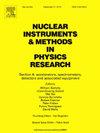Features and performances of the DUNE Far Detectors Photon Detection System
IF 1.5
3区 物理与天体物理
Q3 INSTRUMENTS & INSTRUMENTATION
Nuclear Instruments & Methods in Physics Research Section A-accelerators Spectrometers Detectors and Associated Equipment
Pub Date : 2024-10-28
DOI:10.1016/j.nima.2024.170004
引用次数: 0
Abstract
The Photon Detection Systems of the first two Liquid Argon Time Projection Chambers (LArTPCs) of the DUNE Far Detector exploit the Horizontal and Vertical Drift technologies and are composed of 6000 and 672 photon detection units respectively, named X-Arapuca. The Photon Detection Systems will complement and improve the calorimetry and vertex reconstruction for beam events and the prompt light detection will enable the trigger for non-beam events, such as Supernova Neutrino Bursts. In the Horizontal Drift, the Photon Detection System is placed behind the anode planes of the LArTPC, while in the Vertical Drift it is located on the cathode, biased at 320 kV, thus requiring targeted solutions to power and read the X-Arapuca devices. The X-Arapuca is a photon trap with two light downshifting stages, where the light is conveyed to SiPMs with a large area Wavelength Shifting light guide. Its Photon Detection Efficiency, and consequently the Photon Detection Systems sensitivity to the DUNE physics reaches, is determined by the grade and coupling of its several components. The Photon Detection Systems of both Horizontal and Vertical Drift are presented and discussed in their individual features, with a focus on the photon collector components and on the performances achieved by the X-Arapuca units measured in laboratory and in the CERN facilities at the Neutrino Platform. Possible changes in the baseline X-Arapuca designs proposed to further enhance the Photon Detection Efficiency of both Horizontal and Vertical Drift are also discussed. The Horizontal and Vertical Drift scale 1:20 prototypes at the NP04 and NP02 CERN Neutrino Platform, instrumented with the baseline versions of the X-Arapuca, will be operated with Liquid Argon throughout 2024.
DUNE 远距离探测器光子探测系统的特点和性能
DUNE 远距离探测器的前两个液态氩时间投影室(LArTPCs)的光子探测系统利用了水平漂移和垂直漂移技术,分别由 6000 和 672 个光子探测单元组成,被命名为 X-Arapuca。光子探测系统将补充和改进光束事件的热量测量和顶点重建,而瞬时光探测将能够触发非光束事件,如超新星中微子爆发。在水平漂移中,光子探测系统位于 LArTPC 阳极平面的后面,而在垂直漂移中,它位于阴极上,偏压为 320 千伏,因此需要有针对性的解决方案来为 X-Arapuca 设备供电和读取数据。X-Arapuca 是一种光子阱,有两个光降档,通过大面积波长变换光导将光传送到 SiPM。它的光子探测效率以及光子探测系统对 DUNE 物理的灵敏度取决于其几个组件的等级和耦合。本文介绍并讨论了水平漂移和垂直漂移光子探测系统的各自特点,重点是光子收集器组件以及在实验室和欧洲核子研究中心中微子平台设施中测量的 X-Arapuca 装置所达到的性能。此外,还讨论了为进一步提高水平漂移和垂直漂移的光子探测效率而对 X-Arapuca 基线设计进行修改的可能性。欧洲核子研究中心中微子平台 NP04 和 NP02 上的 1:20 水平和垂直漂移原型将在整个 2024 年期间使用液态氩运行。
本文章由计算机程序翻译,如有差异,请以英文原文为准。
求助全文
约1分钟内获得全文
求助全文
来源期刊
CiteScore
3.20
自引率
21.40%
发文量
787
审稿时长
1 months
期刊介绍:
Section A of Nuclear Instruments and Methods in Physics Research publishes papers on design, manufacturing and performance of scientific instruments with an emphasis on large scale facilities. This includes the development of particle accelerators, ion sources, beam transport systems and target arrangements as well as the use of secondary phenomena such as synchrotron radiation and free electron lasers. It also includes all types of instrumentation for the detection and spectrometry of radiations from high energy processes and nuclear decays, as well as instrumentation for experiments at nuclear reactors. Specialized electronics for nuclear and other types of spectrometry as well as computerization of measurements and control systems in this area also find their place in the A section.
Theoretical as well as experimental papers are accepted.

 求助内容:
求助内容: 应助结果提醒方式:
应助结果提醒方式:


